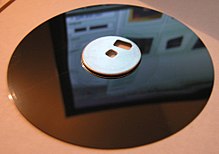
Back Slapskyf Afrikaans قرص مرن Arabic Disquete AST Disket Azerbaijani Дыскета Byelorussian Гъвкав магнитен диск Bulgarian ফ্লপি ডিস্ক Bengali/Bangla Flopi disk BS Disc flexible Catalan فلۆپی دیسک CKB



A floppy disk or floppy diskette (casually referred to as a floppy, a diskette, or a disk) is a type of disk storage composed of a thin and flexible disk of a magnetic storage medium in a square or nearly square plastic enclosure lined with a fabric that removes dust particles from the spinning disk. The three most popular (and commercially available) floppy disks are the 8-inch, 5¼-inch, and 3½-inch floppy disks.[1] Floppy disks store digital data which can be read and written when the disk is inserted into a floppy disk drive (FDD) connected to or inside a computer or other device.[2]
The first floppy disks, invented and made by IBM in 1971,[3] had a disk diameter of 8 inches (203.2 mm).[4] Subsequently, the 5¼-inch (133.35 mm) and then the 3½-inch (88.9 mm) became a ubiquitous form of data storage and transfer into the first years of the 21st century.[5] 3½-inch floppy disks can still be used with an external USB floppy disk drive. USB drives for 5¼-inch, 8-inch, and other-size floppy disks are rare to non-existent. Some individuals and organizations continue to use older equipment to read or transfer data from floppy disks.
Floppy disks were so common in late 20th-century culture that many electronic and software programs continue to use save icons that look like floppy disks well into the 21st century, as a form of skeuomorphic design. While floppy disk drives still have some limited uses, especially with legacy industrial computer equipment, they have been superseded by data storage methods with much greater data storage capacity and data transfer speed, such as USB flash drives, memory cards, optical discs, and storage available through local computer networks and cloud storage.
- ^ "Floppy Disk: History & Definition". Encyclopedia Britannica. 12 March 2009. Archived from the original on 16 June 2024. Retrieved 16 June 2024.
- ^ "IBM History – Floppy disk storage". IBM. 16 May 2024. Archived from the original on 16 June 2024. Retrieved 16 June 2024.
- ^ "Floppy Disks - CHM Revolution". www.computerhistory.org. Archived from the original on 3 January 2017. Retrieved 6 October 2017.
- ^ Cite error: The named reference
Teja_1985was invoked but never defined (see the help page). - ^ Fletcher, Richard (30 January 2007). "PC World Announces the End of the Floppy Disk". The Daily Telegraph. Archived from the original on 2 January 2012. Retrieved 2 August 2020.